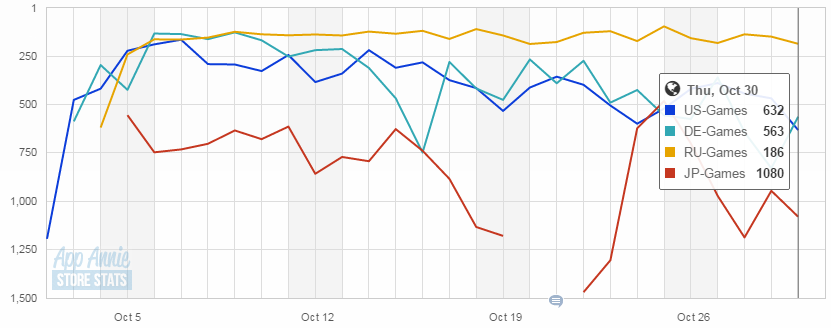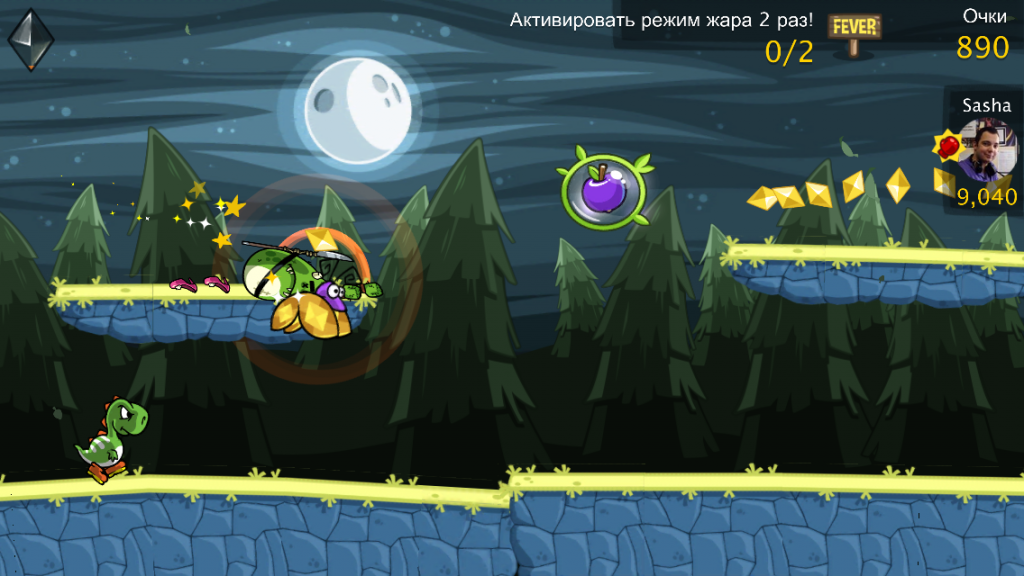The first time we wrote about Boomlagoon (Monsu developer studio) more than two years ago, in April 2012. It was then that it became known that Antti Stén, the lead server programmer of the original Angry Birds, and Tuomas Erikoinen, the lead artist of the entire series, left Rovio to found a new studio in their native Helsinki.

Boomlagoon’s debut project was Noble Nutlings, released at the very beginning of 2013, which can be described in a nutshell as a mix of Bad Piggies and Elasto Mania about protein. The game was not very warmly received (metacritic score – 62 points).

The project’s performance was also far from good (both in terms of cash and downloads). Even after the alteration in Nutlings Tournament, released by LINE, the game did not “come to life” (now both versions of the project are missing in the App Store).
However, this did not prevent the Finns from raising $3.6 million in May 2014 to finalize and publish the Monsu runner, which we will talk about now.
About the game
The concept of the project in a nutshell: a mix of a runner and a collectible card game.
If not in a nutshell.
There is a character – a healthy troll Monsu. With it, you run along a randomly generated track, trying to return the gold stolen by “evil people” from your family castle.

Some enemies can be destroyed by successfully landing on them (hello, Mario), and all buildings are subject to destruction “head-on”. There are only three things to be afraid of on the track: sharp objects, holes and “jams” (the character and the track do not always move synchronously, the character dies without avoiding an obstacle in time).
The player holds up to three cards in his hand, which somehow make it easier for Mons to run over rough terrain. For example, if you put a Big Yeti card in your hand, a yeti will run along the highway with a troll. It will freeze opponents with a certain frequency, depending on the level that is raised by the soft currency (gold).
Actually, the gameplay looks like this: a troll is rushing, and behind him a crowd of henchmen, automatically helping him out.
Collection component
For completing every fifth mission (about them separately below), the player is awarded a random card. Cards can also be purchased in the store. It’s quite standard here: the more you pay, the higher the probability of getting a rarer and more valuable card. The minimum price tag is in soft currency, the average and maximum are in hard currency.
The received cards, as we have already mentioned, can be improved for a soft currency.
They can also be combined to get particularly rare ones. The incident is that in order to get a legendary card, it is usually necessary to find three specific rare cards. Such is the kampugatcha.
The cards are divided not only by rarity (ordinary, rare, epic, legendary and super legendary), but also by type: “personal” (they are used directly by the hero), aerial (monsters that fly) and terrestrial (monsters that run, not fly).
Launch
Every mobile software developer dreams of such a launch – to appear on the main page on the main banner of the App Store in 80 countries (although not on the main Western markets, like the USA and the UK; on the other hand, such a banner in Russia and Japan is also not bad). In addition, the game was included in the list of the best games in more than 127 countries at the same time.
Cool?
Cool!
However, in terms of downloads, this did not bring the project, as far as can be judged from App Annie data, any super-high positions. For all the time in the App Store, the game got into the top ten (overall) in downloads only in 26 countries, and only in 6 countries reached the Top 10 (overall) in terms of box office indicators. In fairness, we note that Monsu got into the gaming Top 10 in 92 countries. However, three weeks after the release, the game is not included in the gaming Top 100 in any country. Curiously, the game, on the contrary, is included in the box office Top 100 (overall), but only in five regions.
As for the dynamics, in terms of retention, everything becomes clear if you look at the chart below. It is curious that even in Russia, where the banner of the game was played on the main page of the App Store, the game reached only the 13th place in overall downloads.

According to cash indicators, everything is not so clear. That is, for a game that has received such a powerful push, it is, of course, a failure, but, in principle, some level of transactions holds.

And now let’s try to figure out (more precisely, to put forward hypotheses) why the game is so bad. I will go through the moments that confused me during the game.
The first moment
The main character is the evil troll Monsu. I understand that the green color did not prevent Shrek from becoming a favorite of the public, but he did not crush people, did not throw spears at houses and certainly did not scatter guards with a shield with spikes. In other words, we have a fear that the audience simply did not accept the hero and the way he was presented.
The second moment
The game does not have a banal thing for runners – a countdown after the game is paused. The player, corny, does not have time to prepare, get ready.
The third moment
In most runners, in case of the player’s first mistake on the track, he is offered to continue running for the minimum possible amount of virtual currency. In Monsu, for some reason, two gems are such. You can’t buy anything for one in the game. No, it is clear that the system is balanced in a certain way (the minimum purchase is 20 crystals). But for me as a player, this is already a certain stress – it’s one thing to give one gem for rebirth, it’s quite another to give two.

The fourth moment
The game has a very interesting solution with missions. In fact, the runner is endless, but the tasks that are given to the player are marked on the map. That is, progress is obvious, although the track is the same throughout the game.
But there is a moment: tasks are often repeated (sometimes every other time). What is more critical is that their complexity, let’s say, is tied, to a greater extent, to luck than to the real skills that the player had to acquire for such and such a mission.

The fifth moment
One of the monetization systems of the game is the consumption of energy for each run. But its problem is that it is completely non-obvious.
It is not explained to the player that energy is required for each run. The energy itself is, let’s say, “hidden”, it is displayed only on one screen in, attention, the form of hearts. The latter are appropriate in match-3, when they take on a loss, then in the runner?
That is, immediately there is a sea of questions to the troll. Where are the five hearts from, why are they being restored? If they had drawn a tenderloin or a chicken leg, everything would be clear, but there is still a moment.
The sixth moment
How points are counted was initially unclear. Usually, points are equated to the number of conditional game meters /steps, but this is not the case in Monsu. For example, 600 meters is almost 10 thousand points.
Moreover, points are given for destroying enemies and buildings. Initially, the game did not show exactly how much, now it has been corrected.
The seventh moment
How gold diamonds, abundantly scattered along the highway, are converted into coins is a mystery. Why it was impossible to make coins is unclear.

The eighth moment
There are very few pieces from which the route is generated. Backgrounds too. There is a feeling that you are always running along the same pre-drawn road. This, of course, is the scourge of most endless runners, but buying content is not an option at all. Players will not seek to run further, explore, they will know that after such and such a number of conditional meters, they will be “repeated”.
The ninth moment
Progress in the game is tied to two components: collecting cards and completing the already mentioned missions. It’s good.
It’s bad that there is no bundle of “level multiplier points”, which, in fact, made Subway Surfers a hit.
In almost any infinite runner, there is either a “threshold” problem or a “fatigue” problem. The first is when at a certain stage the route turns out to be impassable for purely physical reasons. But this, to be honest, seems to me to be a design mistake at all. The second is when you need to spend more and more time to achieve a new record, and the growth of speed and difficulty of passing freezes at the n-level.
Subway Surfers partially solved the second problem. For completing each mission consisting of three tasks from the category “jump 100 times”, the player receives a multiplier of points + 1. In other words, the points start running faster, although the track itself and your speed on it do not change.
This decision gives meaning to game quests, and the player sees progress, his interest in the game remains.
Unfortunately, almost no one uses this solution, but in vain.
The tenth moment
As for the collectible component, one of its main problems is that most of the cards duplicate each other or are completely useless (or perhaps their usefulness is not obvious). In addition, there is no such thing that such a card passes better for the n-passing style, and such a card passes better for another. A rare card is always better than an ordinary one. There are not so many such maps that really affect the gameplay (they exist, and they demonstrate the great potential of the idea).

The eleventh moment
In the game you can buy clothes for Monsu. It does not affect the characteristics, it is impossible to boast of a portrait of a character. The question is: why is it needed?

The twelfth moment
Important bonuses periodically come across on the track. The problem is that some maps completely neutralize them. What, then, is their meaning?
Something like that.
By the way, the only thing that kept me in the game was the leaderboards. The collectible element tied to the passage of missions is boring, there is nothing to pay for in a good way. The only thing left is to try to get ahead of a friend.
